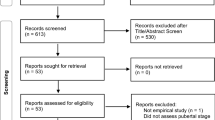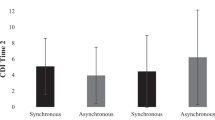Abstract
Previous research has investigated the relationship between pubertal timing and depression in girls, with most results suggesting that earlier menarche predicts more depression in adolescence. However, few studies have controlled for the potentially confounding effects of childhood depressive symptoms. The current study uses a prospective, longitudinal sample of 1,185 girls (47.8 % Caucasian) to examine the relationships between pubertal timing, childhood depressive symptoms, and adolescent depressive symptomatology. Using multiple linear regression analyses, our results suggest that higher levels of childhood depressive symptoms and earlier menarche have independent effects on adolescent depressive symptoms. Surprisingly, childhood depressive symptomatology predicted later age of menarche, although the magnitude of this effect was small. Taken together, the results suggest that early childhood depressive symptoms and early menarche represent independent pathways to later depressive symptoms.
Similar content being viewed by others
References
Achenbach, T. M., & Edelbrock, C. S. (1983). Manual for the child behavior checklist and revised child behavior profile. Burlington, Vermont: University of Vermont, Department of Psychology.
Achenbach, T. M., & Edelbrock, C. S. (1986). Youth self-report profile for girls aged 11–18. Burlington: University of Vermont.
Aiken, L. S., & West, S. G. (1991). Multiple regression: Testing and interpreting interactions. Thousand Oaks, CA: Sage.
Anderson, S. E., & Must, A. (2005). Interpreting the continued decline in the average age at menarche: Results from two nationally representative surveys of U.S. girls studied 10 years apart. Journal of Pediatrics, 147, 753–760.
Angold, A., & Costello, E. J. (2006). Puberty and depression. Child and Adolescent Clinics of North America, 15, 919–937.
Angold, A., Costello, E. J., & Worthman, C. M. (1998). Puberty and depression: The roles of age, pubertal status and pubertal timing. Psychological Medicine, 28, 51–61.
Angold, A., Costello, E. J., Erkanli, A., & Worthman, C. M. (1999). Pubertal changes in hormone levels and depression in girls. Psychological Medicine, 29, 1043–1053.
Belsky, J., Steinberg, L., Houts, R. M., Friedman, S. L., DeHart, G., Cauffman, E., et al. (2007). Family rearing antecedents of pubertal timing. Child Development, 78, 1302–1321.
Bogaert, A. F. (2008). Menarche and father absence in a national probability sample. Journal of Biosocial Science, 40, 623–636.
Bosch, A. M., Willekens, F. J., Baqui, A. H., van Ginneken, J. K. S., & Hutter, I. (2008). Association between age at menarche and early-life nutritional status in rural Bangladesh. Journal of Biosocial Science, 40, 223–237.
Brooks-Gunn, J., Petersen, A. C., & Eichorn, D. (1985). The study of maturational timing effects in adolescence. Journal of Youth and Adolescence, 14, 149–161.
Butts, S. D., & Seifer, D. B. (2010). Racial and ethnic differences in reproductive potential across the life cycle. Fertility and Sterility, 93, 681–690.
Cameron, J. L. (1997). Stress and behaviorally induced reproductive dysfunction in primates. Seminars in Reproductive Endocrinology, 15, 37–45.
Caspi, A., & Moffitt, T. E. (1991). Individual differences are accentuated during periods of social change: The sample case of girls at puberty. Journal of Personality and Social Psychology, 61, 157–168.
Center for Human Resource Research. (2005). NLSY79 User’s Guide. Columbus: The Ohio State University, CHRR NLS User Services.
Center for Human Resource Research. (2009). NLSY79 Child and Young Adult Data Users Guide. Columbus: The Ohio State University, CHRR NLS User Services.
Conley, C. S., & Rudolph, K. D. (2009). The emerging sex difference in adolescent depression: Interacting contributions of puberty and peer stress. Development and Psychopathology, 21, 593–620.
Copeland, W., Shanahan, L., Miller, S., Costello, E. J., Angold, A., & Maughan, B. (2010). Outcomes of early pubertal timing in young women: A prospective population-based study. American Journal of Psychiatry, 167, 1218–1225.
Costello, E. J., Mustillo, S., Erkanli, A., Keeler, G., & Angold, A. (2003). Prevalence and development of psychiatric disorders in childhood and adolescence. Archives of General Psychiatry, 60, 837–844.
Cote, S. M., Boivin, M., Liu, Z., Nagin, D. S., Zoccolillo, M., & Tremblay, R. E. (2009). Depression and anxiety symptoms: Onset, developmental course, and risk factors during early childhood. Journal of Child Psychology and Psychiatry, 50, 1201–1208.
Delemarre-van de Wall, H. A., van Coeverden, S. C. C. M., & Engelbregt, M. J. T. (2002). Factors affecting onset of puberty. Hormone Research, 57, 15–18.
Dobson, H., Ghuman, S., Prabhakar, S., & Smith, R. (2003). A conceptual model of the influence of stress on female reproduction. Reproduction, 125, 151–163.
Edelbrock, C., Costello, A. J., Dulcan, M. K., Kalas, R., & Conover, N. C. (1985). Age differences in the reliability of the psychiatric interview of the child. Child Development, 56, 265–275.
Ellis, B. J. (2004). Timing of pubertal maturation in girls: An integrated life history approach. Psychological Bulletin, 130, 920–958.
Ellis, B. J., & Garber, J. (2000). Psychosocial antecedents of variation in girls’ pubertal timing: Maternal depression, stepfather presence, and marital and family stress. Child Development, 71, 485–501.
Ellison, P. T. (2001). On fertile ground: A natural history of human reproduction. Cambridge, MA: Harvard University Press.
Freedman, D. S., Khan, L. K., Serdula, M. K., Dietz, W. H., Srinivasan, S. R., & Berenson, G. S. (2002). Relation of age at menarche to race, time period, and anthropometric dimensions: The Bodalusa Heart Study. Pediatrics, 110, 1–7.
Garn, S. M., & Bailey, S. M. (1978). Genetics and maturational processes. In F. Falkner & J. M. Tanner (Eds.), Human growth 1: Principles and prenatal growth. New York, NY: Plenum.
Ge, X., Conger, R. D., & Elder, G. H. (2001). Pubertal transition, stressful life events, and the emergence of gender differences in adolescent depressive symptoms. Developmental Psychology, 37, 404–417.
Ge, X., Kim, I. J., Brody, G. H., Conger, R. D., Simons, R. L., Gibbons, F. X., et al. (2003). It’s about timing and change: Pubertal transition effects on symptoms of major depression among African American youths. Developmental Psychology, 39, 430–439.
Goodyer, I. M., Herbert, J., & Altham, P. M. (1998). Adrenal steroid secretion and major depression in 8- to 16-year-olds, III. Influence of cortisol/DHEA ratio at presentation on subsequent rates of disappointing life events and persistent major depression. Psychological Medicine, 28, 265–273.
Goodyer, I. M., Herbert, J., & Tamplin, A. (2003). Psychoendocrine antecedents of persistent first- episode major depression in adolescents: a community-based longitudinal enquiry. Psychological Medicine, 33, 601–610.
Graber, J. A., Brooks-Gunn, J., & Warren, M. P. (1995). The antecedents of menarcheal age: Heredity, family environment, and stressful life events. Child Development, 66, 346–359.
Graham, P. J., & Rutter, M. L. (1968). The reliability and validity of the psychiatric assessment of the child, II: Interview with the parent. British Journal of Psychiatry, 114, 581–592.
Hammen, C. (2002). The context of stress in families of children with depressed parents. In S. Goodman & I. Gotlib (Eds.), Children of depressed parents: Mechanisms of risk and implications for treatment (pp. 175–199). Washington, DC: American Psychological Association.
Huerta, R., & Brizuela-Gamino, O. L. (2002). Interaction of pubertal status, mood and self-esteem in adolescent girls. The Journal of Reproductive Medicine, 47, 217–225.
Joinson, C., Heron, J., Lewis, G., Croudace, T., & Araya, R. (2011). Timing of menarche and depressive symptoms in adolescent girls from a UK cohort. British Journal of Psychiatry, 198, 17–23.
Juruena, M. F., Pariante, C. M., Papadopoulos, A. S., Poon, L., Lightman, S., & Cleare, A. J. (2009). Prednisolone suppression test in depression: Prospective study of the role of HPA axis dysfunction in treatment resistance. The British Journal of Psychiatry, 194, 342–349.
Kaplowitz, P. B. (2008). Link between body fat and the timing of puberty. Pediatrics, 121, 208–217.
Kaplowitz, P. B., Slora, E. J., Wasserman, R. C., Pedlow, S. E., & Herman-Giddens, M. E. (2001). Earlier onset of puberty in girls: Relation to increased body mass index and race. Pediatrics, 108, 347–353.
Kellam, S. K., Branch, J. D., Agrawal, K. C., & Ensminger, M. E. (1975). Mental health and going to school: The Woodlawn program of assessment, early intervention, and evaluation. Chicago, IL: University of Chicago Press.
Kim, K., Smith, P. K., & Palermiti, A. (1996). Conflict in childhood and reproductive development. Evolution and Human Behavior, 18, 109–142.
Klein, D. N., Shankman, S. A., Lewinsohn, P. M., & Seeley, J. R. (2009). Subthreshold depressive disorder in adolescents: Predictors of escalation to full syndrome depressive disorders. Journal of the American Academy of Child and Adolescent Psychiatry, 48, 703–710.
Kovacs, M., & Devlin, B. (1998). Internalizing disorders in childhood. Journal of Child Psychology and Psychiatry, 39, 47–63.
Koziel, S., & Jankowska, E. A. (2002). Effect of low versus normal birthweight on menarche in 14-year-old Polish girls. Journal of Pediatrics and Child Health, 38, 268–271.
Luby, J. L., Belden, A. C., & Spitznagel, E. (2006). Risk factors for preschool depression: The mediating of early stressful life events. Journal of Child Psychology and Psychiatry, 47, 1292–1298.
Luby, J. L., Si, X., Belden, A. C., Tandon, M., & Spitznagel, E. (2009). Preschool depression: Homotypic continuity and course over 24 months. Archives of General Psychiatry, 66, 897–905.
MacDonald, K. (1999). An evolutionary perspective on human fertility. Population and Environment: A Journal of Interdisciplinary Studies, 21, 223–246.
Marshall, W. A., & Tanner, J. M. (1969). Variations in pattern of pubertal changes in girls. Archives of Disorders of Childhood, 44, 291–303.
Negriff, S., & Susman, E. J. (2011). Pubertal timing, depression, and externalizing problems: A framework, review, and examination of gender differences. Journal of Research on Adolescence, 21, 717–746.
Plant, T. M., & Barker-Gibb, M. L. (2004). Neurobiological mechanisms of puberty in higher primates. Human Reproduction Update, 10, 67–77.
Prebeg, Z., & Bralic, I. (2000). Changes in menarcheal age in girls exposed to war conditions. American Journal of Human Biology, 12, 503–508.
Romans, S. E., Martin, J. M., Gendall, K., & Herbison, G. P. (2003). Age of menarche: The role of some psychosocial factors. Psychological Medicine, 33, 933–939.
Rosenfield, R. L., Cooke, D. W., & Radovick, S. (2008). Puberty and its disorders in the female. In M. Sperling (Ed.), Pediatric Endocrinology (3rd ed.). Philadelphia, PA: Saunders Elsevier.
Rutter, M., Tizard, J., & Whitmore, K. (1970). Education, health and behavior. London: Longman.
Spear, L. P. (2000). The adolescent brain and age-related behavioral manifestations. Neuroscience and Biobehavioral Reviews, 24, 417–463.
Styne, D. M. (2004). Pediatric endocrinology. Philadelphia, PA: Lippincott Williams & Wilkins.
Styne, D. M., & Grumbach, M. (2002). Puberty in boys and girls. In D. W. Pfaff, A. P. Arnold, A. M. Etgen, S. E. Fahrbach, & R. T. Rubin (Eds.), Hormones, brain, and behavior: Vol. 4. San Diego, CA: Academic Press.
Tahirović, H. F. (1998). Menarchal age and the stress of war: An example from Bosnia. European Journal of Pediatrics, 157, 978–980.
Toppari, J., & Juul, A. (2010). Trends in puberty timing in humans and environmental modifiers. Molecular and Cellular Endocrinology, 324, 39–44.
Walvoord, E. C. (2010). The timing of puberty: Is it changing? Does it matter? Journal of Adolescent Health, 47, 433–439.
Young, E. A., Midgley, A. R., Carlson, N. E., & Brown, M. B. (2000). Alteration in the hypothalamic-pituitary- ovarian axis in depressed women. Archives of General Psychiatry, 57, 1157–1162.
Zill, N., & Peterson, J. L. (1986). Behavior Problems Index. Washington, DC: Child Trends, Inc.
Author information
Authors and Affiliations
Corresponding author
Rights and permissions
About this article
Cite this article
Black, S.R., Klein, D.N. Early Menarcheal Age and Risk for Later Depressive Symptomatology: The Role of Childhood Depressive Symptoms. J Youth Adolescence 41, 1142–1150 (2012). https://doi.org/10.1007/s10964-012-9758-7
Received:
Accepted:
Published:
Issue Date:
DOI: https://doi.org/10.1007/s10964-012-9758-7




